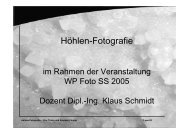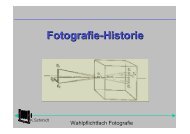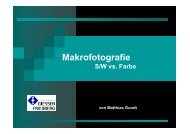Mathematik für Ingenieure (Teil 1) - Fachbereich 13 MND
Mathematik für Ingenieure (Teil 1) - Fachbereich 13 MND
Mathematik für Ingenieure (Teil 1) - Fachbereich 13 MND
Sie wollen auch ein ePaper? Erhöhen Sie die Reichweite Ihrer Titel.
YUMPU macht aus Druck-PDFs automatisch weboptimierte ePaper, die Google liebt.
U. Abel, <strong>MND</strong>: Ingenieurmathematik WS 2006/07 40<br />
Satz 5.9. (Potenzfunktion)<br />
Es sei 2 R konstant. Dann gilt<br />
Satz 5.10.<br />
(x ) 0 = x 1 <strong>für</strong> alle (0; +1) :<br />
Es gelte h (x) = [f (x)] g(x) mit f (x) > 0. Dann gilt<br />
h 0 (x) = h (x) [g (x) ln f (x)] 0 :<br />
Satz 5.11. (Trigonometrische Funktionen)<br />
Die Funktionen sin x; cos x; tan x; cot x sind an jeder Stelle ihres De…nitionsbereiches<br />
di¤erenzierbar mit<br />
1. (sin x) 0 = cos x;<br />
2. (cos x) 0 = sin x;<br />
3. (tan x) 0 = 1<br />
cos 2 x = 1 + tan2 x;<br />
4. (cot x) 0 =<br />
Satz 5.12.<br />
1<br />
sin 2 x = 1 cot2 x:<br />
Es sei ! eine Konstante mit ! 6= 0.<br />
1. Die Funktion<br />
y (x) = a cos !x + b sin !x (a; b 2 R)<br />
genügt der Di¤erentialgleichung (DGL)<br />
y 00 (x) + ! 2 y (x) = 0:
















